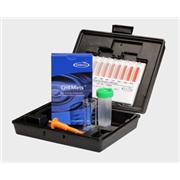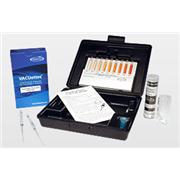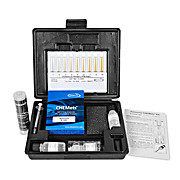Water Quality Test Kits, Water Quality, CHEMetrics, Supplies
-
 Dissolved Oxygen CHEMets® Kits
CHEMetrics
Dissolved Oxygen CHEMets® Kits
CHEMetricsThe level of dissolved oxygen in natural waters is often a direct indication of quality, since aquatic plants produce oxygen, while microorganisms generally consume it as they feed on pollutants. At low temperatures the solubility of oxygen is increased; during summer, saturation levels can be as…
-
Molybdate CHEMets Kit, Range: 20-200 ppm
CHEMetricsMolybdate is used throughout the industrial water treatment and power generation industries as a corrosion inhibitor in both open- and closed-loop cooling water systems. In solution, molybdate anions complex with oxidized iron to form a protective film of molybdate and ferric-oxide. Molybdate is…
-
Nitrate CHEMets Kit, Range: 0-2700 ppm
CHEMetricsNitrate is the most completely oxidized form of nitrogen. It is formed during the final stages of biological decomposition, either in wastewater treatment facilities or in natural water supplies. Low-level nitrate concentrations may be present in natural waters. However, a Maximum Contaminant Level…
-
Filming Amine (aliphatic amine) CHEMets Kit
CHEMetricsKit comes in a cardboard box and contains everything needed to perform 20 tests: Refill, Comparator, reaction tube with lid, tip breaking tool, and instructions. Filming amines are fed continuously into boiler feedwater to protect metal surface from corrosion cuased by dissolved oxygen and…
-
DEHA Titrets Kit
CHEMetricsDissolved oxygen in boiler system water causes corrosion and pitting of metal surfaces, which can lead to boiler inefficiency, equipment failure, and system downtime. DEHA (N,N-Diethylhydroxylamine) is added to boiler system water as an oxygen scavenger to keep the dissolved oxygen levels as low as…
-
Because of its strong oxidizing properties, chlorine is an excellent biocide used to treat potable waters, municipal wastes, and swimming pools. When used to treat potable water, chlorine helps alleviate the adverse effects of iron, manganese, ammonia, and sulfide. The Maximum Residual Disinfectant…
-
Hydrogen peroxide is a strong oxidizing agent with a variety of uses. Applications include the treating of industrial effluents and domestic waste and serving as a disinfectant in aseptic packaging. The Ferric Thiocyanate Method Reference: D. F. Boltz and J. A. Howell, eds.,…
-
Because of its strong oxidizing properties, chlorine is an excellent biocide used to treat potable waters, municipal wastes, and swimming pools. When used to treat potable water, chlorine helps alleviate the adverse effects of iron, manganese, ammonia, and sulfide. The Maximum Residual Disinfectant…
-
Kit comes in a plastic case and contains everything needed to perform 30 tests (except distilled water): Refill, Low and High Range Comparators, dilutor snapper cup, micro test tube, and instructions. Range: 0-60 & 60-600 ppm MDL: 10 ppm Method: Direct Nesslerization …
-
DEHA Vacu-vials Kit
CHEMetricsDissolved oxygen in boiler system water causes corrosion and pitting of metal surfaces, which can lead to boiler inefficiency, equipment failure, and system downtime. DEHA (N,N-Diethylhydroxylamine) is added to boiler system water as an oxygen scavenger to keep the dissolved oxygen levels as low as…
-
Sulfite (free) Titrets® Titration Cells
CHEMetricsSulfite is not usually present in surface waters. If sulfite is discharged in effluents or from domestic wastewaters, it readily oxidizes to form sulfate. Sodium sulfite is the most common form of sulfite and is an excellent reducing agent with applications as an oxygen scavenger. Sulfite…
-
Chlorine Comparator
CHEMetricsThe CHEMetrics chlorine comparator is ideal for drinking water applications, by detecting the percentage of chlorine present in water. It is easy to use and ensures accurate testing.
-
Ozone SAM Kit
CHEMetricsOzone is a strong oxidizing agent and is used as an alternative to chlorine as a biocide in the disinfection of drinking water. Ozone is used to remove odor, decolorize, and to control algae and other aquatic growths. Ozone is also used in various disinfectant and sterilization processes in…
-
Copper (Soluble) CHEMets Kit
CHEMetricsCopper is naturally present in the earth’s crust and in seawater. Copper-containing fungicides are used to control biological growth in water supplies. The Maximum Contaminant Level Goal for copper is 1.3 mg/L in drinking water. The measurement of copper is an important means of…
-
Water Purification System Accessories
CHEMetricsThe CHEMetrics accessory is suitable for use with water purification system, which ensures best water quality by resisting airborne contaminants. This accessory is carefully designed with durable construction to ensure optimum performance.
-
Bromine CHEMets Kit
CHEMetricsBromine, a less volatile compound than chlorine, is used as a sanitizing agent in drinking water systems, swimming pools, and spas. The bromine test method employs the DPD chemistry. Potassium iodide is added to the sample before analysis. Bromine reacts with the iodide to liberate iodine. The…
-
Hydrogen peroxide is a strong oxidizing agent with a variety of uses. Applications include the treating of industrial effluents and domestic waste and serving as a disinfectant in aseptic packaging. The Ferric Thiocyanate Method Reference: D. F. Boltz and J. A. Howell, eds.,…
-
Phenols VACUettes® Kits
CHEMetricsPhenol (hydroxybenzene) is the simplest of a group of similar organic chemicals, which includes cresols, xylenols, and catechols. Phenol itself is a common ingredient of disinfectants. In drinking water, low-level phenolic concentrations impart a foul taste and odor, especially upon chlorination.…
-
Hardness is a measure of the mineral content of water. Calcium and magnesium are the most common minerals that contribute to hardness. Hard water causes scaling in boilers and other industrial equipment, and diminishes the effectiveness of soaps and detergents. The EGTA Method (Calcium) …
-
Chloride Vacu-vials® Kits
CHEMetricsChloride is the most common inorganic anion found in water and wastewater. The Maximum Secondary Contaminant Level for drinking water for chloride is 250 mg/L. Natural sources of salt are the ocean and various salt deposits above and below ground. Chloride is very corrosive to most metals in…
-
Ammonia HBA Test Kit
CHEMetricsLow-level ammonia nitrogen may be naturally present in water as a result of the biological decay of plant and animal matter. Higher concentrations in surface waters can indicate contamination from waste treatment facilities, raw sewage, industrial effluents (particularly from petroleum refineries),…
-
Cyanide (Free) CHEMets Kit
CHEMetricsCyanide is used in many chemical and refining processes. It is found in effluent from electroplating and metal cleaning operations, coke ovens, steel manufacturing facilities, and gas scrubbers. Although cyanide can be safely removed by alkaline chlorination, its acute toxicity to aquatic life…
-
Hardness is a measure of the mineral content of water. Calcium and magnesium are the most common minerals that contribute to hardness. Hard water causes scaling in boilers and other industrial equipment, and diminishes the effectiveness of soaps and detergents. The EDTA Method (Total) …
-
Kit comes in a plastic case and contains everything needed to perform 30 tests (except distilled water): Refill, Low and High Range Comparators, dilutor snapper cup, micro test tube, and instructions. Range: 0-30 & 30-300 ppm MDL: 5 ppm Method: Direct Nesslerization …
-
Because of its strong oxidizing properties, chlorine is an excellent biocide used to treat potable waters, municipal wastes, and swimming pools. When used to treat potable water, chlorine helps alleviate the adverse effects of iron, manganese, ammonia, and sulfide. The Maximum Residual Disinfectant…
-
Phosphate Vacu-vials® Kits
CHEMetricsPhosphorus occurs naturally in rock formations in the earth's crust, usually as phosphate. High phosphate concentrations in surface waters may indicate fertilizer runoff, domestic waste discharge, or the presence of industrial effluents or detergents. Although phosphates from these sources are…
-
Ammonia Vacu-vials Kit, Range: 0-14.0 ppm
CHEMetricsLow-level ammonia nitrogen may be naturally present in water as a result of the biological decay of plant and animal matter. Higher concentrations in surface waters can indicate contamination from waste treatment facilities, raw sewage, industrial effluents (particularly from petroleum refineries),…
-
Iron in Brine CHEMets Kit
CHEMetricsIron is present in nature in the form of its oxides, or in combination with silicon or sulfur. The soluble iron content of surface waters rarely exceeds 1 mg/L, while ground waters often contain higher concentrations. The National Secondary Drinking Water Standard for iron is 0.3 mg/L, as iron…
-
Iron is present in nature in the form of its oxides, or in combination with silicon or sulfur. The soluble iron content of surface waters rarely exceeds 1 mg/L, while ground waters often contain higher concentrations. The National Secondary Drinking Water Standard for iron is 0.3 mg/L, as iron…
-
Ozone Vacu-vials Kit
CHEMetricsOzone is a strong oxidizing agent and is used as an alternative to chlorine as a biocide in the disinfection of drinking water. Ozone is used to remove odor, decolorize, and to control algae and other aquatic growths. Ozone is also used in various disinfectant and sterilization processes in…
-
Low-level ammonia nitrogen may be naturally present in water as a result of the biological decay of plant and animal matter. Higher concentrations in surface waters can indicate contamination from waste treatment facilities, raw sewage, industrial effluents (particularly from petroleum refineries),…
-
Hydrazine CHEMets Kit
CHEMetricsHydrazine is a powerful reducing agent that is used in various chemical processes and in boiler water as an oxygen scavenger. To control corrosion, residual hydrazine typically is maintained in the 0.05 to 0.1 mg/L range. Higher levels may be used to guard against corrosion when the boiler is out…



































